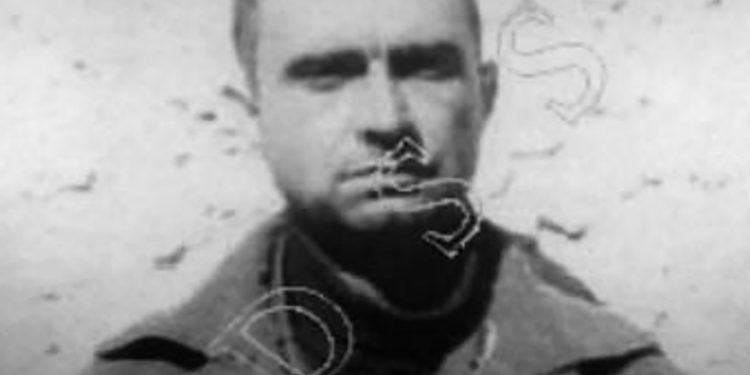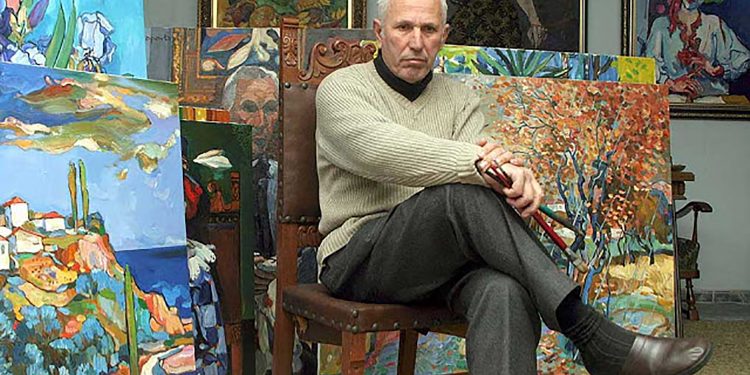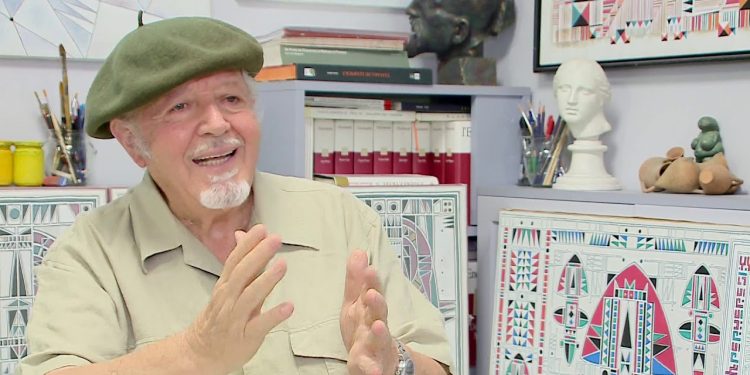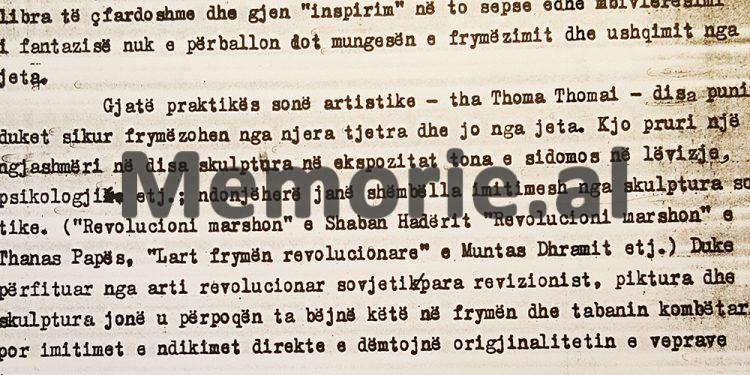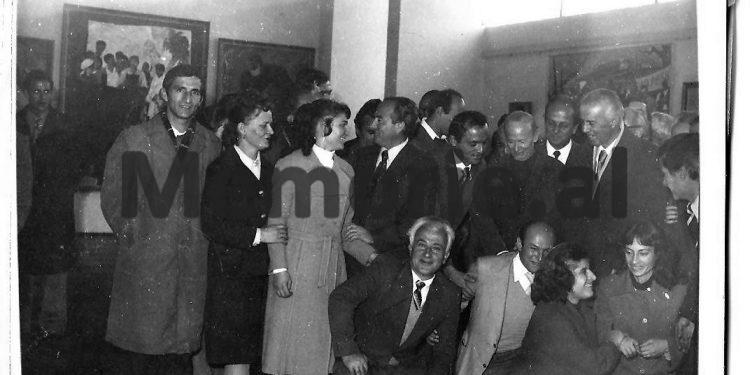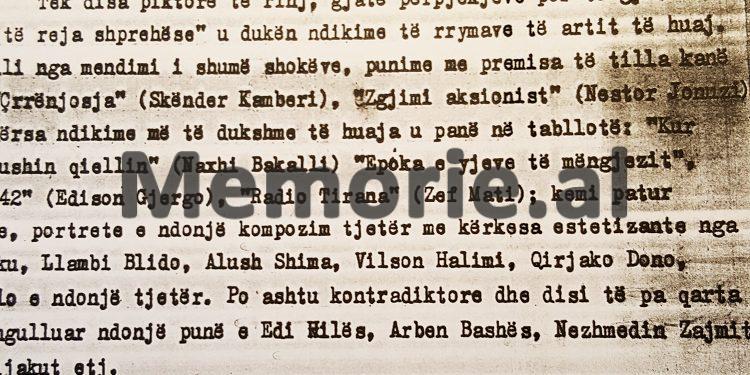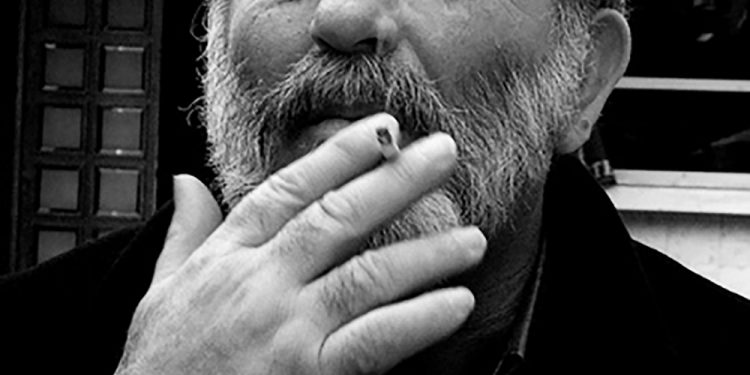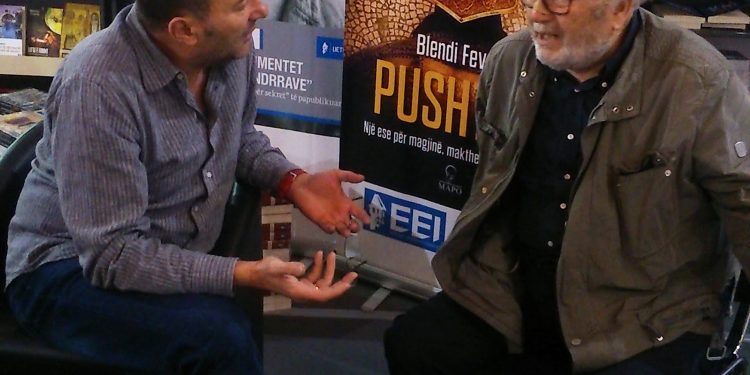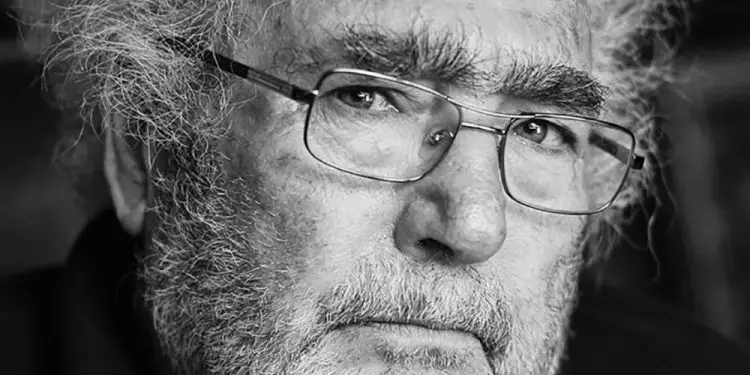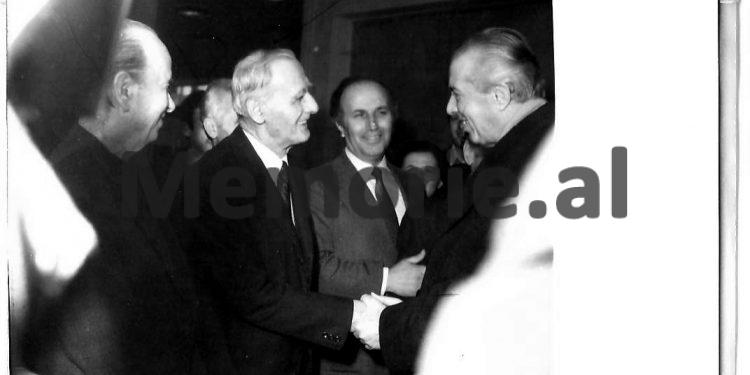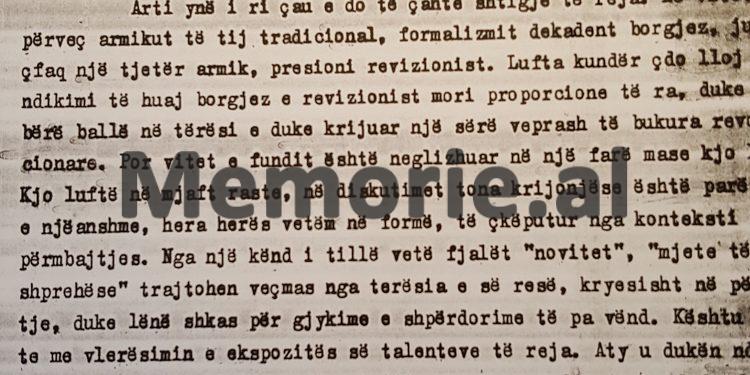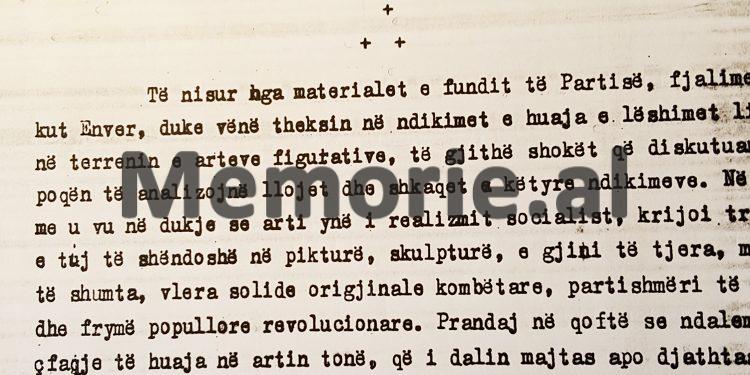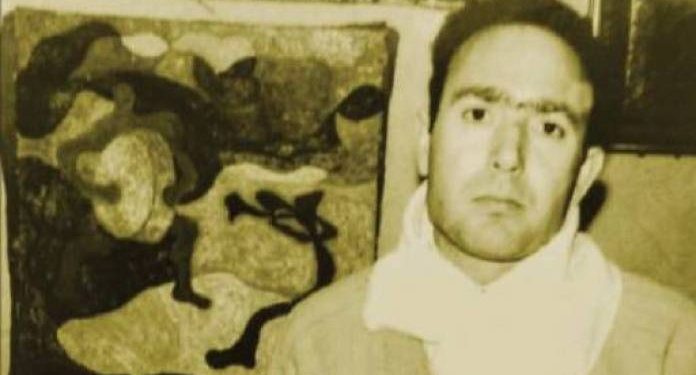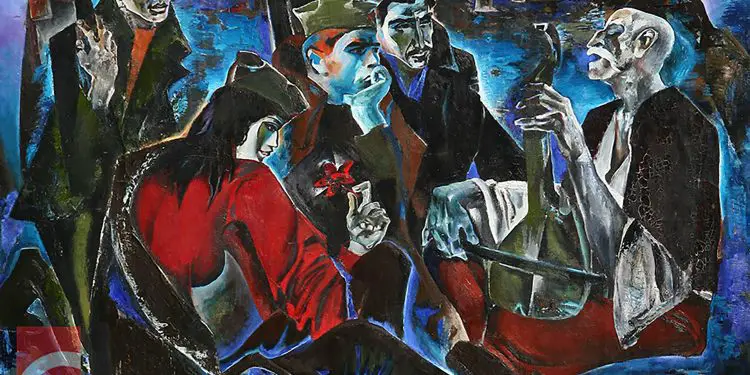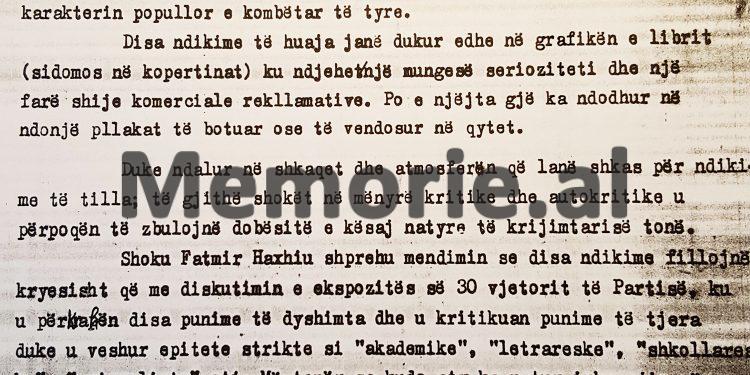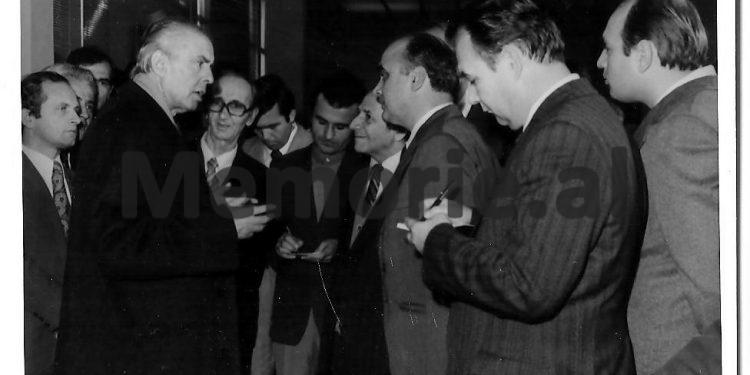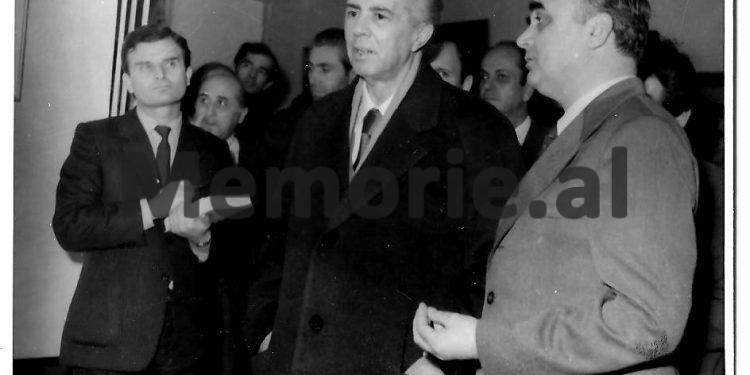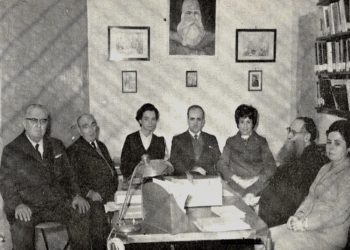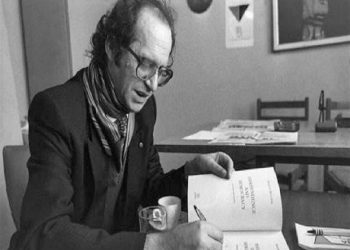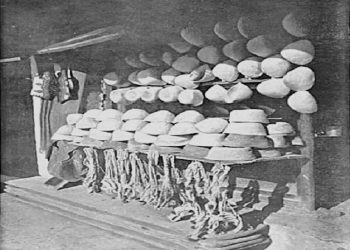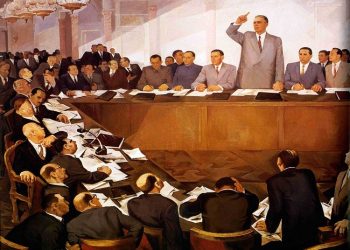Dashnor Kaloçi
Memorie.al publishes an unknown report-information compiled by the sector of Figurative Arts at the League of Writers and Artists of Albania in 1973, in which it is about a meeting that took place in the League where the work of painters and sculptors, which was held under the “spirit of the word of Comrade Enver Hoxha” held on March 15 and 16 of that year with the only “Liberal performances and foreign influences on art and culture”, where he for the first time first criticized and publicly hit the 11th Radio Television Song Festival. The detailed analysis made in that report-information to painters such as Max Velo, Edision Gjergo, Ali Oseku, Naxhi Bakalli, Alush Shima, Nestor Jonuzi, Skënder Kamberi, etc., who were criticized for paintings with foreign influences and the marking of Hamit Beqes at the head of the report-information, where it is said: “In the file, we have other material that we can give to comrade Enver”.
This article is taken from the book “Writers and Artists under the communist dictatorship”, author Dashnor Kaloçi, which is expected to be published soon and is published in homage to the famous architect and painter, Max Velo, who passed away yesterday afternoon. who for years suffered in the prisons of the communist regime of Enver Hoxha, precisely because of his creativity as a painter and architect.
Among the many meetings that took place in all cultural and artistic institutions of Tirana at the beginning of 1973 after the speech of Enver Hoxha held on March 15 and 16 in the office of the Presidium of the People’s Assembly of Albania, where the main topic was “War against foreign and liberal performances in art and culture and their impact on the whole life of the country… ”, also in the Writers ‘and Artists’ League a series of meetings were held where the work is done up to that time and the tasks that were undertaken were analyzed. in the future, artists and writers would come out, “in the spirit of Comrade Enver’s speech held in the Fourth Plenum.” One of these meetings held in May of that year in the League of Writers and Artists of Albania, was also that of the figurative arts sector, whereafter it, based on the rules on which the League operated, the relevant secretary (Secretary of the League of Writers and Artists for Figurative Arts), has compiled the relevant report-information for the Central Committee of the ALP. Also, another report-information on this meeting was given by Kujtim Buza, who at that time held the position of Secretary for Figurative Arts at the Ministry of Education and Culture, a report which together with that of the Section of Figurative Arts of Hamit Beqja, Ramiz Alia’s assistant in the education sector at the apparatus of the Central Committee of the ALP, who informs the head of his, that “in the file, we have other materials that can be given to Comrade Enver”. What is noticeable in both reports-information in question, is the fact that there seems to be reflected with “correctness and truthfulness” everything that has been said and spoken by participants, painters, sculptors, art critics, etc. because in addition to criticism or more precisely the charges against Edison Gjergos, Ali Oseku and Max Velos, etc., who, as is well known, have been imprisoned by the communist regime for years (these reports were also the “raw material” and the basis for filling the files of their) authors of reports have not spared even painters and other sculptors, well-known names of fine arts such as Sali Shijaku, Muntaz Dhrami, Guri Madhi, Nexhmedin Zajmi, etc., who not only do not they had problems afterward but on the contrary we were quite appreciated. What is further stated in the two reports-information compiled by the Sector of Figurative Arts made the League of Writers and Artists of Albania and that by Kujtim Buza of the Ministry of Education, who were the painters and other sculptors who were criticized or accused there for modernist influences and foreign performances in their works? In this regard, we are aware of the document in question that is published for the first time in the pages of this book, which we are giving in full and without any abbreviations.
Hamit Beqa’s note for Ramiz Alia
Comrade Ramiz.
In the two materials for the fine arts, there are also unexplained problems to the end as well as …… .. (writing is not understood) their different meanings. We will request that these treatments be made more complete in the League Plenum for Figurative Arts.
In the file, we also have some reproductions of paintings and sculptures not only from those that have been criticized but also from those that have been considered valuable.
We can talk about whether we should give them to Comrade Enver.
20. IV. 1973 Hamit Beqja
Information of the Sector of Figurative Arts at the League of Writers and Artists for Ramiz Alia
I N F O R M A T I O N
ON THE FIGHT AGAINST FOREIGN INFLUENCES IN FIGURATIVE ARTS
We are giving preliminary information on some of the problems of foreign influences in the fine arts, which emerged from the discussion at the committee meeting at the Writers ‘and Artists’ League. We will provide more complete information after the plenum that will consider the state of the fine arts in recent years, which will be convened by the end of April.
Based on the latest materials of the Party, the speeches of Comrade Enver, emphasizing the foreign influences and liberal concessions in the field of fine arts, all the comrades who discussed tried to analyze the types and causes of these influences. It was argued that our art of socialist realism established its sound tradition in painting, sculpture, and other genres, with numerous works, solid original national values, high partisanship, and popular revolutionary spirit.
Therefore, if we dwell on some foreign performances in our art that go to the left or right of his revolutionary path, we do so in order to preserve its most positive features and sound spirit, national physiognomy, and purity.
Where, and how, did foreign influences appear in the fine arts?
Even before that, we have had special cases of works with foreign influences. We have not exhibited them and we are left with that. In recent years, these performances have been numerous, especially in the exhibition of young talents, in the one with the portrait of the working class, in the exhibition of the 30th anniversary of the Party, in the first exhibition of spring in Tirana and in some district exhibition (Durrës, Shkodër). , personal (Skënder Kamberi, Nestor Jonuzi). Foreign influences have also appeared in the scenography of our theaters, in the graphics of the book (covers and illustrations) on the tiles.
Even before that there has been a series of influences, numerically fewer (in painting) especially impressionist manners. (These works are characterized by an ambiguity of realistic form, giving more impression than deepening and analysis of figures and the environment). But in recent years in the exhibitions we mentioned, the impacts seemed more diverse.
In some cases, as in the spring exhibition and in some districts, a shallow theme with insignificant subjects has been noticed, with some following small and random motives. Some young painters, while trying to find “new means of expression”, were influenced by the currents of foreign art. As the opinion of many friends suggests, works with such premises have been: “Eradication” (Skënder Kamberi), “Share Awakening”, (Nestor Jonuzi), etc. While significant foreign influences were seen in the paintings “When the stars fill the sky”, (Naxhi Bakalli), “Epic of the morning stars”, “Well 524”, (Edison Gjergo), “Radio Tirana”, (Zef Mati), we had landscapes, portraits and any other composition with aesthetic requirements by Ali Oseku, Llambi Blido, Alush Shima, Vilson Halimi, Qirjako Deno, Maks Velo, and others. Also contradictory and somewhat unclear are the works of Edi Hilë, Arben Basha, Nexhmedin Zajmi, Sali Shijak, etc.
Among the works we have mentioned, exposed or unexposed, these influences (apart from works with poor and shallow themes), are distinguished in the tendency to alienate habits and techniques from contemporary heterogeneous formalist European art (mainly from some current of the beginning of our century). ), such as cubism, expressionism, symbolism, etc. This is expressed in the way the concept is conceived, in the vague drawing, in the colors and forms, sometimes very abstracted and exalted, sometimes without expression or contradiction with the claimed content. Although those currents are not identical, borrowing “something” from them, these works are in front of obvious influences, fading and distorting the real truth, sometimes creating equivocation in content and more than once creating another cliché of lifeless schematism.
The use of expressive means (form, drawing, composition, color), are seen somewhat isolated from the ideo-aesthetic whole of the work, it’s content. We have had influences of this kind in the scenography of recent years. What is called either by a loading, straining of objects on stage, without the sound of reality, or by minimizing the necessary atmosphere, reducing scenographic solutions to unrealistic elements and objects, simplified beyond measure and logic? There are also signs of “modernism”, and the indiscriminate stylization of folk costumes that sometimes lose their originality and their own popular character.
Some foreign influences have also been seen in the graphics of the book (especially the covers), where there is a lack of seriousness and a certain commercial taste. The same thing happened on any tiles published or placed in the city.
By dwelling on the causes and the atmosphere that gave rise to such influences, all the comrades critically and self-critically tried to discover the weaknesses of this nature of our creativity.
Comrade Fatmir Haxhiu expressed the opinion that some influences start mainly with the discussion of the exhibition of the 30th anniversary of the Party, where some dubious works were supported and other works were criticized wearing strict epithets such as “academic”, “literary”, “schoolgirl”. ”,“ Naturalist ”, etc. More than anywhere else, there has been an encouragement for new “forms,” he said.
Other friends shared the view that one should not be isolated in an exhibition. Various professional weaknesses and remarks have been made for many years in a row.
On the other hand, by making professional remarks about one or several jobs (such as schooling, schematic, naturalistic), there have not always been accurate arguments. More than once simple professional remarks, from personal preference, have taken the phenomenon of a professional platform, wherein close circles, such works, said Xenophon Dilo, is neither true nor accurate but denigrating (schematism is also liberal, scholasticism it has nothing to do with any platform, while naturalism, for example, is also a very recent trend of “avanguardism”, European formalism).
By attributing such tendencies to one another, there has been a marked confusion and a place for proven and inaccurate theories.
For years, Foto Stamo said, the “old-fashioned” version did not help for a healthier creative spirit. Some work from subjective judgments – he said, became an exemplary flag such as “The Epic of the Morning Stars” (Edison Gjergo), and “Planting Trees” (Edi Hila). I have had remarks, about the assessments related to them, expressed in Andon Kuqali’s articles in “Drita” and “Nëntori”.
Our new art broke and would pave new paths. In the 1960s, in addition to his traditional enemy, decadent bourgeois formalism, another enemy, revisionist pressure, appeared to you. The struggle against any foreign bourgeois and revisionist influence took on new proportions, resisting them altogether and creating a series of beautiful revolutionary works. But in recent years this war has been somewhat neglected. This war, in many cases, in our creative discussions has been seen a little one-sidedly, at times only in form, detached from the context of the content.
From such an angle, the very words “innovation”, “new means of expression”, are treated separately from the whole of the cloud, mainly in content, leaving room for inappropriate judgments and abuses. This was the case with the evaluation of the new talent exhibition. There were clear foreign influences on some of the creations, but our attention to such performances was characterized by unjustified tolerance. Even when in this exhibition there were liberal formalist influences (in the works of Nestor Jonuzi, Skënder Kamberi, Zef Matit, etc.), and there was criticism (a wide discussion at the Institute of Arts, an article, in “November”, etc.), still again, the problems did not deepen, they remained isolated under sentimental and unprincipled concessions, taking the young ages “en bloc” as the enrichment of our artistic traditions, without analyzing, scrutinizing the values and not the creative values of differentiated authors.
As many friends have said, from a low theoretical and critical level in the treatment of some ideo-aesthetic and professional problems of our art, there has been a kind of ideo-aesthetic confusion that has caused subjective tendencies, evaluation, and theorizing, Andon Kuqali said that he was disturbed by the apathy of some old painters, their inactivity which has caused a gradual professional decline of their creativity (sisters Zengo, Kaceli, etc.), as well as the closed creativity in studios like Janaq Paço, who has many works, studies of figures but without any social themes, while in exhibitions he brings weak works. While Edison Gjergo, Naxhi Bakali, and Alush Shima are said to be working hard, but we do not recognize these efforts, we have not seen these works. Our art said Andon Kuqali has had other influences, especially from impress had other influences especially from Impressionism and among experienced painters. (Nexhmedin Zajmi, Guri Madhi, etc.).
Even Wilson Kilica said that our art assimilated some impressive impressions into the manner, for many years (especially in landscapes, any portrait, composition). Many of today’s influences come first because there are aesthetic concepts between us in practice and theory. There is a certain aesthetic confusion and sometimes foreign concepts unrelated to the healthy path of our art. It hardly makes such a clear division, e.g. Ali Oseku. We do not yet have a clear critical sense of foreign creativity. It is also not very clear that we have theoretically elaborated on the support on the national floor. Some have nihilistic appreciative concepts for previous artists.
Among the young talents, in particular, we have few painters and sculptors who know our cultivated traditions and the values of the diverse folk tradition. Few of them (in the whole mass of painters and sculptors), who have love and preserve objects of popular beauty – said among others Dhimitër S. Shuteriqi.
The successes of our socialist art do not adequately identify objectively. They do not write about the successes of the works of our colleagues, of our art, following step by step the continuation of all our artistic creativity as well as every creator in particular. From the feelings and thoughts expressed accurately, in parallel with the artistic practice, for our beauty, the futility of any influence of any younger or more experienced creator would be understood and fought. Some of these influences – said a friend, come from a simple fact that the Party has always pointed out to us from the insufficient and always active connection of the civic artist with the living life of the country. When he doesn’t learn from life, then he inevitably opens any books and finds “inspiration” in them because even the overestimation of fantasy cannot withstand the lack of inspiration and food from life.
During our artistic practice – said Thoma Thomai – some works seem to be inspired by each other and not by life. This brought a resemblance to some sculptures in our exhibitions and especially in psychological movements etc. Sometimes they are examples of imitations of Soviet sculpture. (Shaban Haderi’s “Revolution Revolves”, Thanas Papa’s “Revolt Revolution”, Muntaz Dhrami’s “Upstairs Revolutionary Spirit”, etc.) Taking advantage of Soviet revolutionary art before revisionism, our paintings and sculptures tried to do so in spirit and sole. national, but imitations and direct influences damage the originality of our works.
Noticing the insufficient and sometimes weak work of our literary and artistic bodies, there is a need for an illustrated magazine of 2-3 months, which will systematically summarize and treat the whole sphere of practice and ideo-aesthetic problems of the fine arts.
Albanian Writers and Artists Association
Figurative Arts Sector
Memorie.al






